The Economics and Statistics Division maintains archives of previous publications for accountability purposes, but makes no updates to keep these documents current with the latest data revisions from Statistics Canada. As a result, information in older documents may not be accurate. Please exercise caution when referring to older documents. For the latest information and historical data, please contact the individual listed to the right.
<--- Return to Archive
For additional information relating to this article, please contact:
June 18, 2020NOVA SCOTIA QUARTERLY POPULATION ESTIMATES AS OF APRIL 1, 2020 The production of the demographic estimates are based on methods and models that allow reliable and accurate population estimates; however, in the context of the COVID-19 pandemic, the assumptions of the models maybe invalid and administrative data sources are not optimal in terms of timeliness and completeness. Statistics Canada has released a technical supplement on how production methods were modified for Q1 estimates. Adjustment for deaths were made by adding the reported COVID-19 deaths as of March 31 (total of 96 in Canada) to the estimate from the usual method. Emigrant, returning emigrants and net temporary emigrants estimates were adjusted lower on examination of auxiliary data sources showing a slowing trend. The usual methods for births, immigration and interprovincial migration were not modified for Q1 estimates. Further methodological changes are under consideration to produce Q2 estimates.

Nova Scotia’s population increased by 817 between January 1, 2020 and April 1, 2020. The population as of April 1, 2020 was 978,274, the highest population for Nova Scotia on record. Since April 1, 2015 Nova Scotia's population has increased by 42,003. This quarter's increase reflects an increase in immigrants, net interprovincial migration and net nonpermanent residents and a decrease in natural population change.
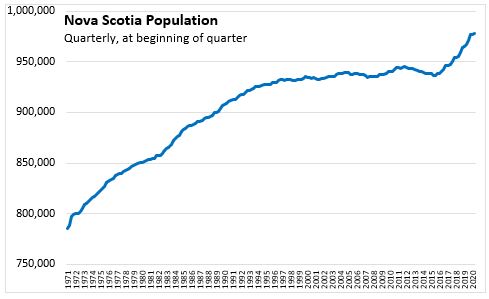
There are seasonal patterns in quarterly population changes, particularly evident in births and international migration. In recent years, the first quarter has been slower than Q2 and Q3 for the year. This quarter's population change is smaller than the first quarter change from any of the past four years.
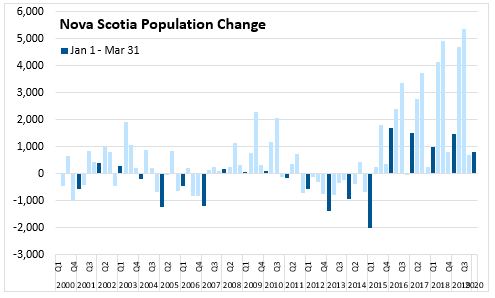
In the latest quarter, Nova Scotia’s population increased by 0.08 per cent compared to the January 1 estimate, below the pace as the national population which grew 0.20 per cent. Compared with April 1, 2019 Nova Scotia’s population has increased by 1.20 per cent, or 11,565, while the national population grew by 1.50 per cent.
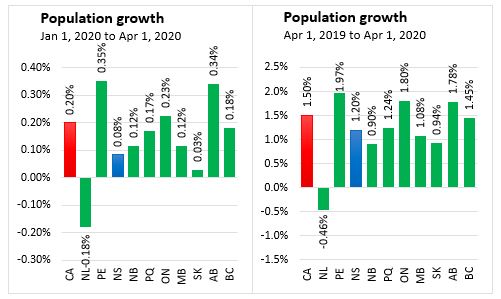
In recent years, immigration from other countries has been a strong contributor to population growth in Nova Scotia. Nova Scotia received 1,185 immigrants during the first quarter of 2020. Quarterly immigration continues to be higher than historical averages.
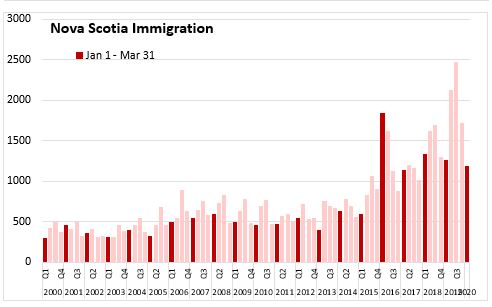
Net non-permanent residents can be a key component of quarterly demographic growth. In this quarter, Nova Scotia saw a net gain of 125 non-permanent residents since January 1, 2020. Non-permanent residents typically only have has a small change in Q1.
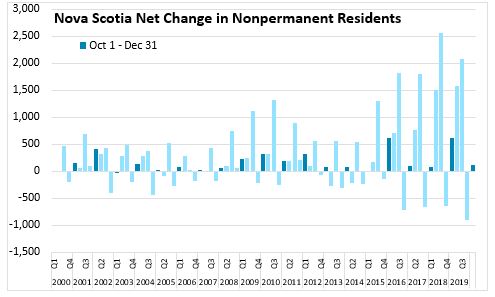
Nova Scotia’s natural population change (the number of births, less the number of deaths) has been negative for several years. Between January 1, 2020 and March 31, 2020, there were 2,050 births and 2,747 deaths, amounting to a natural population decline of 697.
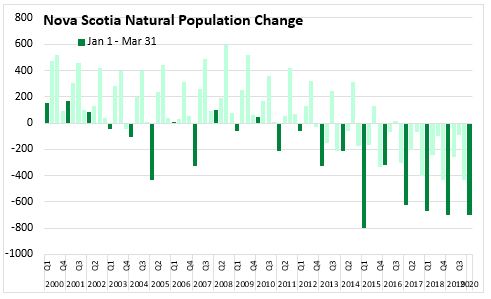
Interprovincial migration has historically shown a net outflow of Nova Scotia's population to other provinces. However, over the past four years, the population has grown through interprovincial movements. This quarter, Nova Scotia had a net inflow interprovincially of 292 with a net inflow from five provinces.
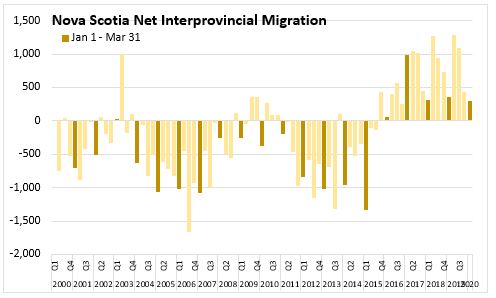
Out-migration from Nova Scotia to other provinces increased by 539 persons to 4,520 compared to the first quarter of 2019. Out-migration increased to Newfoundland and Labrador, Prince Edward Island, Quebec, Ontario, Manitoba, Saskatchewan, and British Columbia.
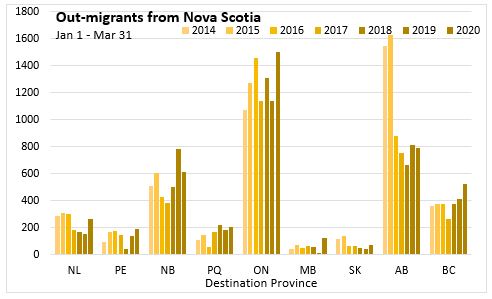
Compared to Q1 2019, in-migrants to Nova Scotia increased by 467 to 4,812 for Q1 2020. The largest in-migrant increases was from Ontario (460).

Interprovincial migration to Nova Scotia was a net inflow of 292 persons in Q1 2020. There were net inflows from five provinces with largest coming from Ontario (+412), Saskatchewan (+78) and Newfoundland and Labrador (+65). The largest net outflow was to British Columbia (-89), Quebec (-62) and Nunavut (-121).
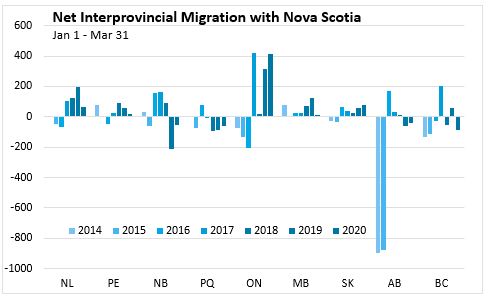
Source: Statistics Canada.
Table 17-10-0009-01 Population estimates, quarterly
Table 17-10-0020-01 Estimates of the components of interprovincial migration, quarterly
Table 17-10-0040-01 Estimates of the components of international migration, quarterly
Table 17-10-0045-01 Estimates of interprovincial migrants by province or territory of origin and destination, quarterly
Table 17-10-0059-01 Estimates of the components of natural increase, quarterly
<--- Return to Archive